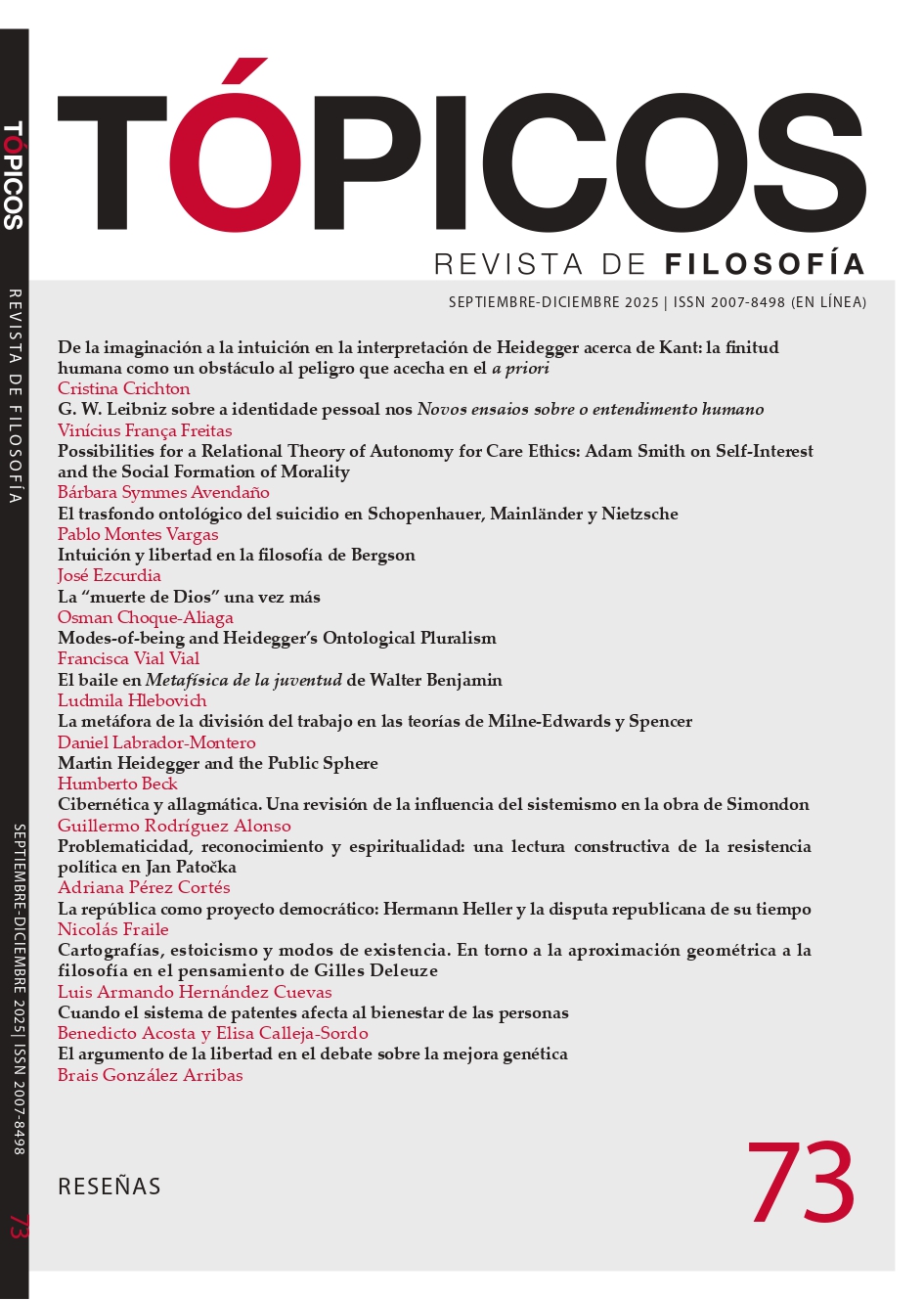Published 2025-08-25
Keywords
- transhumanism,
- human genome,
- morphological freedom,
- procreative autonomy,
- equity
- genetic manipulation,
- eugenics,
- bioconservatism,
- democratic control,
- healthcare system ...More
Copyright (c) 2025 Tópicos, Revista de Filosofía

This work is licensed under a Creative Commons Attribution-NonCommercial-NoDerivatives 4.0 International License.
How to Cite
Abstract
This article studies the use of the category of freedom by several of the most influential transhumanist thinkers to justify intervening in the human genome for enhancement purposes. Thus, it analyses the principles of morphological freedom and procreative autonomy, the main ways in which the idea of freedom is discussed in this field of study. It also examines the corrections and nuances that transhumanism itself proposes to these principles, since it is difficult to harmonise them with equality or social equity, as well as the arguments presented by bioconservative thinkers who are critical of transhumanism and the genetic manipulation of the human species for its bio-enhancement. The conclusion invites us to take this public debate seriously so that any genetic manipulation in humans carried out with the aim of enhancing the species is subject to democratic control.
References
- Baylis, F. y Robert, J. S. (2004). The Inevitability of Genetic Enhancement Technologies. Bioethics, 18(1), 1-26. https://doi.org/10.1111/j.1467-8519.2004.00376.x
- Berlin, I. (1958). Dos conceptos de libertad. En I. Berlin, Sobre la libertad (pp. 205-255). Pablo de Azcárate (trad.). Alianza.
- Bostrom, N. (2003). Human Genetic Enhancement: A Transhumanist Perspective. The Journal of Value Inquiry, 37(4), 493-506. https://doi.org/10.1023/B:INQU.0000019037.67783.d5
- Bostrom, N. (2005). A History of Transhumanist Thought. Journal of Evolution and Technology, 14(1), 1-25. https://doi.org/10.5840/jpr_2005_26
- Bostrom, N. (2008). Why I Want to Be a Posthuman when I Grow Up. En B. Gordijn y R. Chadwick (eds.), Medical Enhancement and Posthumanism (pp. 107-136). Springer. https://doi.org/10.1007/978-1-4020-8852-0_8
- Brock, D. W. (2017). ¿Es incorrecto elegir a nuestros hijos? En N. Bostrom y J. Savulescu (eds.), Mejoramiento humano (pp. 263-288). I. Ramia y A. Jiménez (trads.). Teell.
- Buchanan, A., Brock, D. W., Daniels, N. y Wikler, D.(2002). Genética y justicia. C. Piña (Trad.). Cambridge University Press.
- Camps, V. (2002). ¿Qué hay de malo en la eugenesia? Isegoría, 27, 55-71. https://doi.org/10.3989/isegoria.2002.i27.554.
- Chislenko, A. S., Sandberg, A., Kamphuis, A., Staring, B., Fantegrossi, B., Reynolds, D., Pearce, D., Otter, D., Bailey, D., Leitl, E., Alves, G., Wagner, H., Aegis, K., Elis, K., Crocker, L. D., More, M., Sverdlov, M., Vita-More, N., Bostrom, N., Fletcher, R., Spaulding, S., Morrow, T. O. y Quinn, T. (2013). Transhumanist Declaration. En M. More y N. Vita-More (eds.), The Transhumanist Reader (pp. 54-55). Wiley-Blackwell.
- Constant, B. (2020). La libertad de los antiguos frente a la de los modernos, seguida de Libertad de pensamiento. C. Fernández Muñoz (Trad.). Página Indómita.
- Fukuyama, F. (2003). Our Posthuman Future: Consequences of the Biotechnology Revolution. Farrar, Strauss, and Giroux.
- Fuller, S. (2016). Morphological Freedom and the Question of Responsibility and Representation in Transhumanism. Confero Essays on Education Philosophy and Politics, 4(2), 33-45. https://doi.org/10.3384/confero.2001-4562.161206
- Habermas, J. (2002). El futuro de la naturaleza humana. ¿Hacia una eugenesia liberal? R. S. Carbó (trad.). Paidós.
- Harris, J. (2017). Los mejoramientos son una obligación moral. En N. Bostrom y J. Savulescu (eds.), Mejoramiento humano (pp. 137-161). I. Ramia y A. Jiménez (trads.). Teell.
- Hughes, J. (1996). “Embracing Change with All Four Arms:” A Posthumanist Defence of Genetic Engineering. Eubios Journal of Asian and International Bioethics, 6(4), 94-101
- Hughes, J. (2004). Cytizen Cyborg. Westview.
- Kass, L. (2002). Life, Liberty and the Defence of Dignity: The Challenge for Bioethics. Encounter Books.
- Mies, M. y Shiva, V. (2014). Ecofeminismo. Teoría, crítica y persepctivas. M. Bofill (trad.). Icaria.
- More, M. (1993). Technological Self-transformation: Expanding Personal Extropy. Extropy, 10(4)(2), 15-24.
- More, M. (2013). The Philosophy of Transhumanism. En M. More y N. Vita-More (eds.), The Transhumanist Reader (pp. 3-17). Wiley-Blackwell. https://doi.org/10.1002/9781118555927.ch1
- Piedra, J. (2019). Technological Enhancement and Happiness: A Review of Morphological Freedom. Cosmos and History, 15(1), 275-291.
- Raymond, J. (2002). Women as Wombs: Reproductive Technologies & the Battle Over Women’s Freedom. Spinifex Press.
- Rawls, J. (1971). A Theory of Justice. Harvard University Press. https://doi.org/10.4159/9780674042605
- Riechmann, J. (2016). ¿Derrotó el smartphone al movimiento ecologista? Catarata.
- Rothblat, M. (2013). Mind is Deeper than Matter. Transgenderism, Transhumanism, and the Freedom of Form. En M. More y N. Vita-More (eds.), The Transhumanist Reader (pp. 317-326). Wiley-Blackwell. https://doi.org/10.1002/9781118555927.ch31
- Rueda Etxebarria, J. (2020). De la libertad morfológica transhumanista a la corporalidad posthumana: convergencias y divergencias. Isegoría, 63, 311-328. https://doi.org/10.3989/isegoria.2020.063.02.
- Sandberg, A. (2013). Morphological Freedom—Why We Not Just Want It, but Need It. En M. More y N. Vita-More (eds.), The Transhumanist Reader (pp. 56-64). Wiley-Blackwell. https://doi.org/10.1002/9781118555927.ch5
- Sandel, M. (2007). Contra la perfección. La ética en la era de la ingeniería genética. R. Vila Vernis (trad.). Marbot.
- Savulescu, J. (2001). Procreative Beneficence: Why We Should Select the Best Children. Bioethics, 15(5/6), 413-426. https://doi.org/10.1111/1467-8519.00251
- Savulescu, J. (2012). ¿Decisiones peligrosas? Una bioética desafiante. Blanca Rodríguez y Enrique Bonete (Trads.) Tecnos.
- Singer, P. (2017). Decisiones de los padres y mejoramiento humano. En N. Bostrom y J. Savulescu (eds.), Mejoramiento humano (pp. 289-301). I. Ramia y A. Jiménez (trads.). Teell.
- Sloterdijk, P. (2000). Normas para el parque humano. T. Rocha (trad.). Siruela.
- Sorgner, S. L. (2021). El futuro de la educación: mejoramiento genético y metahumanidades. Ethika+, 3, 303-333. https://doi.org/10.5354/2452-6037.2021.61703
- Sorgner, S. L. (2022). We Have Always Been Cyborgs—Digital Data, Gene Technologies, and an Ethics of Transhumanism. Bristol University Press. https://doi.org/10.1332/policypress/9781529219203.001.0001
- Tatchell, J. (2015). Making Human Rights Fit for the 21st Century: The Challenge of Morphological Freedom. Social Epistemology Review and Reply Collective, 4(8), 34-39.
- Vita-More, N. (2013). Life Expansion Media. En M. More y N. Vita-More (eds.), The Transhumanist Reader (pp. 73-82). Wiley-Blackwell, 73-82. https://doi.org/10.1002/9781118555927.ch7





